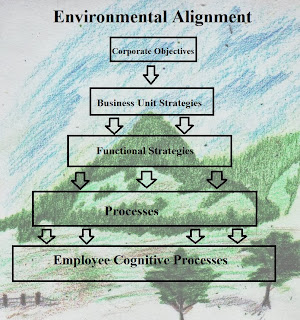Corporate competitiveness is a
process that requires continually adjustment to the market to increase
efficiency and effectiveness. A paper by Bhattachariya and Gibbons (1996),
discusses in further depth how this environmental alignment can be achieved. By
ensuring organizations are structured in a way that improves competitiveness,
they can also help secure a place in the global economy.
Greater
internationalization, consumer choice, fragmented markets, and short product
cycles are some of the challenges organizations face. Companies increasingly are forced to change
with environmental demands and are
attempting to do this through transformation of their structure. A proper
transformation should align the organization and everything within it to corporate
strategies that match the market environment.
Two
primary constraints influence businesses, which include the external
environment and a level of performance that is sufficient to deal with that
environment. To find the balance means one must find a strategy that positions
the organization into a competitive stance. That strategy is a way to achieve
an objective; it is a path to a goal.
The
external environment is the environment, which the organization is currently
working. It may be global in nature, could include the local labor market, or
focus on regulatory environments. It is all of the pressures and factors found
through a proper environmental scan. The performance level of the organization
should be able to compete effectively in that market if there is to be success.
The entire structure should be aligned to the
environmental needs. This requires the ability to ensure processes and
procedures are fulfilling the organizations functions. If these processes
and procedures do not fulfill a competitive need or are not aligned to the market,
then it is necessary to reduce them as waste.
Success
can come through creating number of adjustments within the layers of structure
and the alignment of related processes. This includes the strategy, the
business unit strategies, the functional strategies, processes, and
competencies/capabilities. The business unit strategies take
into consideration actual functional aspects of the firm. This includes
marketing, financial, purchasing, and manufacturing, etc…
Each
strategy should focus on what the organization does well. If innovation is a
core competency, all processes and procedures should align to the environment
in a way that further enhances these abilities. For example, innovation
would require a level of experimentation, collaboration, flatter organizational
structure, and open-minded management, and constant communication. The organization
should seek to develop processes and procedures that enhance this innovation to
compete in an environment with lower product cycle times and competitive
offerings.
The author does not discuss cognitive processes. As processes and procedures are learned employees naturally begin to change the way they think about proper work functions. The longer such processes and procedures are used the more they become embedded within the organizational culture and the mindset of the employees. To have a truly transformational change requires the changing of thoughts and behavior.
It
is possible to make conclusions about environmental alignment as a process:
-Adjusting
organizational strategy to match environmental demands.
-Adjusting
business unit (departmental) strategies to match organizational strategies.
-Create
functional strategies that are in alignment with the departmental and corporate
strategies.
-Adjust
processes to fulfill the functional strategies, departmental strategies and
corporate strategies.
-Encourage
new employee cognitive and behavioral strategies that match the needs of the
processes, functional strategies, departmental strategies, business unit
strategies and organizational strategies.
Bhattacharya, A. & Gibbons, A.
(1996). Strategy formulation: focusing on core competencies and processes. Business Change & Re-engineering, 3 (1).

No comments:
Post a Comment